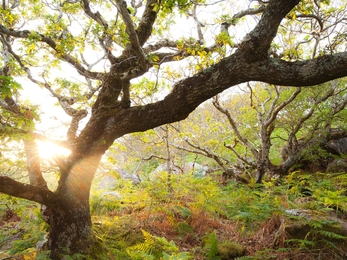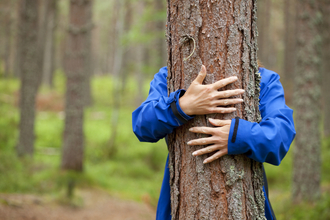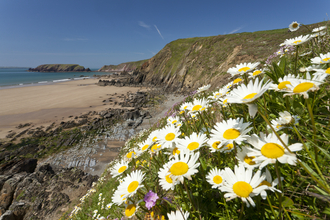Great places to see ancient and unusual trees
Veteran trees are steeped in history and folklore, and ancient coppices give us clues about the way our ancestors used the land. Mature woodland is home to a wealth of wildlife, including rare native trees and iconic woodland flowers. Even damaged, dead and fallen trees are invaluable for the deadwood and habitats they provide for birds, beetles and fungi. Whether it's a gnarled oak, ancient ash stool or veteran holly, The Wildlife Trust’s reserves offer a chance to experience the magic and wonder of trees whose roots are deeply entwined with human history.
It’s not often that we can go in search of wildlife that is guaranteed to show up, be spectacular at all times of the year and be impossible to frighten away

Marsland Oak, Devon - Gavin Black. You can meet this iamazing tree at Devon Wildlife Trust's Marsland nature reserve
Find ancient and unusual trees near you
Do a little research in advance and find out some of the best Wildlife Trust reserves to see ancient and awe-inspiring trees.
North
Cheshire Wildlife Trust
Warburton’s Wood is an ancient clough woodland with small meandering waterfalls from a tributary of the River Weaver. The umbrella of trees above you includes the mighty oak, ash, wych elm, hazel, hawthorn and guelder rose. Hunter’s Wood is adjacent to the site and also boasts rare wild service and small-leaved lime trees.
Cumbria Wildlife Trust
Grubbins Wood - Woodland has probably been present at Grubbins Wood since medieval times. A feature of the wood today are the stands of yew, which grow on extremely thin soils and cast a deep shade year round so that little can grow beneath. Elsewhere oak, birch and ash are common and the less common small leaved lime and wild service tree can be found.
Durham Wildlife Trust
Baal Hill - This ancient woodland belonged to the bishops of Durham in the 14th century and was coppiced for many years. Today most of the trees are of uniform age, but the Bishops Oak is a rare exception and probably over 400-years-old. Come and see it in April, when the ground beneath it is carpeted in bluebells.
Yorkshire Wildlife Trust
Moorlands - Originally a Victorian woodland garden, which is why ancient beech and native rowan trees mix with non-native snake bark maple, dawn redwood, rhododendrons and azaleas.
Adel Dam - Among the many trees here is a particularly large coppiced alder – one of the biggest of its kind. The woods and lake support a large number of bird and invertebrate species, including all three woodpeckers. Visit in spring for a spectacular display of bluebells or in autumn for abundant fungi.
Midlands
The Wildlife Trust for Birmingham and Black Country
Moseley Bog was the childhood playground of The Lord of the Rings author JRR Tolkien, who lived nearby. The atmospheric site is said to have inspired the wild forests he described in his books. There are many gnarled old trees here, including a 300 year old oak. Where is it? 3 miles S of Birmingham centre, between Sparkhill and Billesley.
Where is it? 3 miles S of Birmingham centre, between Sparkhill and Billesley. Entrances along Yardley Wood Rd. Grid ref: SP 094 821
Derbyshire Wildlife Trust
Lea Wood - This ancient woodland is the Trust’s newest reserve. Look out for ‘the battling trees’ - an ancient oak and beech growing close to each other and seemingly fighting to gain the upper hand. The woodland, which was once part of the Lea Hurst estate, owned by Florence Nightingale’s family, also boasts wild daffodils, pied flycatcher and lesser spotted woodpecker.
Where is it? 1 1/2 miles E of Cromford. Grid ref: SK 318 558
Lincolnshire Wildlife Trust
Tortoiseshell Wood - Some fine examples of oaks that are more than 150-years-old can be seen here, together with a large number of rare wild service trees. Other unusual plants worth visiting for include common cow-wheat, enchanter’s nightshade and butterfly orchid, and lucky spring visitors may hear the melodious song of the nightingale.
Where is it? 9 1/2 miles S of Grantham. Grid ref: SK 963 197
Nottinghamshire Wildlife Trust
Bunny Wood is referred to in the Domesday Book and was probably used by Saxon settlers as a source of wood. In 1487 Henry VII and his army camped nearby on their way to the Battle of East Stoke. The size of the old coppice stools gives an indication of the wood’s age; coppiced wych elm and ash are the most common tree species.
Shropshire Wildlife Trust
The Hollies - These 200 windswept, broken, ancient holly trees scattered on the north-east edge of the Stiperstones are sight to behold. Branches used to be harvested as winter animal fodder; this occasional pruning reinvigorated the trees, keeping them young.
Staffordshire Wildlife Trust
Brankley Pastures - Once an ancient wood pasture, then largely cleared, Brankley Pastures is now under long term restoration. The gnarled trunks of the surviving veteran trees provide habitats for many types of insects, birds, mammals, plants and fungi.
Where is it? A515 N 1 1/2miles from Yoxall, R to Scot Hill, L at crossroads after 1 1/2 miles. Park on R after 1/4 mile. Grid ref: SK 166 213
Worcestershire Wildlife Trust
Piper's Hill & Dodderhill Commons - These two old commons were originally maintained as a wood pasture and contain more than 240 veteran trees, which are some of the oldest in the county. It is one of the best woodlands in the region for ancient trees and the many fungi species they support, including chanterelle, beefsteak and various bracket fungi. All three woodpecker species can also be found here.
Where is it? 2 miles N of Hanbury near Bromsgrove. Grid ref: SO 960 649
South
Avon Wildlife Trust
Folly Farm - Wildflower meadows and woodland surround the Folly Farm Centre at the heart of Folly Farm, a 250-acre nature reserve between Bath and Bristol which offers spectacular views over Chew Valley Lake and the Mendips. There are ancient oaks to be found here that are over 400-years-old, the folly oak being one.
Willsbridge Valley on the edge of Bristol is an oasis of wildlife amongst modern housing estates. There is one ancient field maple at the Mill that is huge and very old for its species. It is thought to be 300-400 years old.
The Wildlife Trust for Beds, Cambs & Northants
Gamlingay Wood - There is ancient ash coppice here estimated to be at least 450 years old and still growing well. The wood is also home to rare wild service trees, common spotted orchids and an array of fungi.
Cornwall Wildlife Trust
Devichoys Wood - Ancient woodland is rare in Cornwall and this is a valuable remnant dating back until at least the 1600s. Ancient coppiced sessile oaks have formed gnarled and twisted shapes, and the woodland is also notable for common stinkhorn and dog stinkhorn fungi.
Devon Wildlife Trust
Marsland Valley - A reserve on the northern border of Devon and Cornwall extending inland from a dramatic coastline. In spring the woods are alive with birds and flowers and the gnarled oaks are smothered in mosses, lichens and ferns.
Dorset Wildlife Trust
Girdlers Coppice - This centuries-old area of ancient oak woodland and hazel coppice slopes down to flood meadows by the River Stour. Much is still traditionally managed in a coppice rotation. The rare wild service tree can be found here, and rich ground flora in summer attracts many butterfly species.
Hants and Isle of Wight Wildlife Trust
Pamber Forest - The Donkey Tree is a 300-350 year old English oak famous in local folk lore. A man with a donkey is said to have travelled daily through the forest, until one day the beast stopped and refused to budge. The man tied it to the tree and left it there. This strange story is so well known that it has almost certainly saved the tree from being felled.
Roydon Woods - See the magnificent beech at this reserve within the New Forest National Park. Standing at more than 100ft tall and over 100ft across, it dominates the skyline for miles around and no doubt many woodsmen have sat in its shade over the centuries.
Sussex Wildlife Trust
The Mens - Ancient wood where towering cathedrals of beech form a high canopy over hawthorn, oak, mosses, ferns and flowers. The centuries-old Idehurst Oak (girth six metres), lost a limb in 2011. This precious deadwood has been left as a habitat for beetles and fungi.
Wiltshire Wildlife Trust
The Firs - Three 200-year-old oak pollards stand sentinel on the reserve’s western boundary, in what was once the Royal Forest of Braydon. Although The Firs woodland was planted with oak and ash in the 1920s, these pollards are part of an old hedgebank.
Herefordshire Wildlife Trust
Nupend Wood - This woodland dates back to the 1600s and has been coppiced for many centuries. One old, coppiced, small-leaved lime tree can be found near the old quarries and, uniquely for the area, a large stand of well-established ancient yews grow along the top of the ridge. The occasional wild service tree can also be found here.
East
Essex Wildlife Trust
Thorndon Country Park - One of Essex’s most famous and distinctive trees is ‘The Crinoline Lady’ in Thorndon Country Park, where Essex Wildlife Trust runs the Thorndon Countryside Centre. This 350-450-year-old oak owes its distinctive shape to livestock damage, producing so many burrs around its trunk that it was named after its resemblance to the crinoline petticoats once worn by ladies.
Gernon Bushes - This reserve near Epping has many ancient hornbeam pollards. The 79 acre site is the last remnant of the old Coopersale Common that once linked Epping Lower Forest along the hill ridge to Ongar Park. Look out for rare marsh fern among the wetland plants growing here.
Norfolk Wildlife Trust
Hethel Old Thorn stands in a tranquil setting at the edge of a tiny south Norfolk village, nestling beside the church and its peaceful churchyard. At 700-years-old it is the oldest hawthorn on record in East Anglia. And at 0.025 hectares, it is the smallest Wildlife Trust nature reserve in the country.
Thursford Wood - At only 10 ha Thursford Wood is one of the smaller NWT woodland reserves, but because it contains a great many ancient oak trees, some of which are over 500-years-old, its biodiversity and ecological importance are far higher than woods ten times its size. The reserve is part of the North Norfolk Woods Living Landscape.
Suffolk Wildlife Trust
Captain’s Wood - There are some beautiful veteran oaks at this ancient woodland site, which has been owned and managed by bishops, noblemen and moneyed families since the Middle Ages. Fallow deer roam freely through the spacious wood and one of the greatest expanses of bluebells in the county carpet the woodland floor in spring.
Isle of Man
Manx Wildlife Trust
Cooildarry - A deep wooded valley forming the upper part of Glen Wyllin through which the Ballalonna River runs in a series of waterfalls. The woodland, dominated by elm, ash, alder, sycamore and beech, also includes exotic species such as rhododendron, Portugal and cherry laurel and Corsican pine.
Wales
Radnorshire Wildlife Trust
Cwm Byddog - Ranked as one of the top 20 ancient tree sites in Wales, Cwm Byddog is a hotspot for former oak pollards – one 6.3m in girth – and also a 5m alder. Some are thought to be 750-800 years old. There are also rare veteran tree lichens and in springtime bluebells and early purple orchid to enjoy.
Gwent Wildlife Trust
Margaret’s Wood - A beautiful woodland, situated on the lower slopes of the Whitebrook valley, in the Wye Valley Area of Outstanding Natural Beauty. The wood has some fine examples of mature oak and beech. Other species include cherry, yew, birch and holly.
Strawberry Cottage Wood - This ancient upland oak wood and SSSI boasts two mature specimens of one of the UK’s rarest native trees, the wild service tree. This tree has maple-like leaves which turn red in the autumn, and white flowers which turn into brown leathery fruits. Other woodland plants include St John’swort, violets, yellow archangel, meadowsweet and wood melick.
Montgomeryshire Wildlife Trust
Coed Pendugwm - Majestic sessile oaks have nurtured this quiet corner of Wales for over 400 years providing leafy cover for plants and animals and creating a ‘wild wood’ – the likes of which once covered large areas of the country. This SSSI supports dormice, pied flycatcher and dipper and gives a good display of woodland flowers in spring.
North Wales Wildlife Trust
Coed Crafnant - This reserve is important for its variety of primitive plants such as mosses, ferns and liverworts; these rely on a warm, moist atmosphere to survive. The native oak tree canopy has provided this environment for some 6,000 years. The woods are also home to many different insects, birds and mammals.
The Wildlife Trust of South and West Wales
Pwll-y-Wrach - A wonderful ancient woodland running along both sides of a steep-sided river valley with cascades of waterfalls. Features some fine examples of mature hollow oak trees over 150 years old, along with elm, wild service, ash, alder and spindle. Uncommon ground flora includes bird nest and early purple orchids, toothwort and meadow saxifrage.
Coed Penglanowen - Typical of woods associated with large houses in west Wales, this reserve is full of large, mature trees including ash, beech, sessile oak, wych elm and grand fir. The most striking specimen is the county’s tallest tree - a giant redwood (Sequoiadendron giganteum).
Scotland
Scottish Wildlife Trust
Woodhall Dean - Steep slopes down to the burns that run through the reserve have protected these remnants of ancient woodland. A stand of ancient multi-stemmed oaks, last coppiced in the 1880s, remain as evidence of the traditional woodland management techniques practiced here in the past, and many veteran oaks thought to be more than 300 years old can be seen growing low in the glens.
Carstramon Wood - One of the largest semi-natural broadleaved woodlands in the area, comprising a mix of ancient coppiced woodland around the Doon of Castramont and long-established woodland in the northern half, planted over 200 years ago. Ancient beech pollards are found throughout the wood, inhabited by a number of rare insects.
Northern Ireland
Ulster Wildlife Trust
Glenarm Nature Reserve - One of the best wood pasture/parklands in the British Isles, with old sweet chestnut and lime trees, as well as veteran and phoenix oaks. Other species include red squirrel, silver-washed fritillary, Real’s wood white, intermediate wintergreen and toothwort.
What to look for
While walking under the boughs of a gnarled oak is impressive enough, but make sure you see the wood for the trees. Whether it's a treecreeper heading up a trunk, fungi, or nuts gnawed by squirrels and dormice, there is always plenty to see and hear in the woods. After all, to walk amongst trees is to be immersed in the landscape, where even within quite small pockets of woodland, the clamour of urban neighbourhoods or the creep of intensive farming vanish. In woodlands we can slow down and let the rich sights, sounds, smells and feel of trees and the wildlife they contain wash over us, reconnecting us with nature.
If you can't get there
Trees have deep roots in many communities and even if you can’t get to one of the special sites listed above, the chances are that there is a special tree close to you. Search parks, roadsides, village greens and local woodlands to find a tree whose boughs span the ages of mankind.
More wildlife experiences
From seeing colourful wildflowers to spotting magnificent birds of prey, we can help you get closer to wildlife across the UK.







